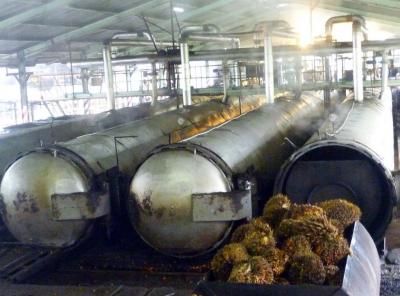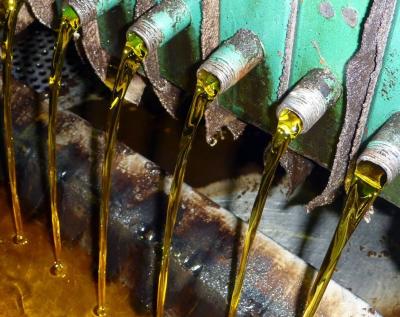Science at work 16 March 2023
- Home
- Our activities, our impact
- Tropical value chains
- Oil palm

Oil palm
Oil palms originated in tropical Africa, and are grown widely in tropical zones, notably in Asia. Since time immemorial, they have provided food, materials and healthcare and hygiene products. Oil palm is the world's main source of vegetable oil, and produces two types of oil at the same time: palm oil and palm kernel oil. Some 80% of palm oil, of which the two leading producers are Malaysia and Indonesia, is used for human consumption and to produce derivatives for industrial use.
An elegant palm that originated in Africa
The oil palm is an elegant palm that originated in the Gulf of Guinea. It takes its species name, Elaeis guineensis, from the ancient Greek elaia , which means olive, due to its oil-rich fruits. Since time immemorial, it has been part of a "gathering economy", picked for food in tropical Africa. It arrived in South America in the 16th century, but did not arrive in Asia until the start of the 20th century, initially in Sumatra and then in Malaysia, where it really took off from the 1960s onwards.
The leaves, or fronds, surround and protect the terminal bud. New leaves are emitted constantly in the centre of the crown, while the old leaves are cut or dry out. The fronds measure between 6 and 9 metres and comprise more than 300 blade-like leaflets on several levels. The base of the leaf, or petiole, is edged with sharp spines.
The trunk, or stem, has a constant diameter and no branches, but the diamond-shaped remains of the cut leaves spiral around it.
The flowers are grouped in inflorescences, some male and others female, in the axil of each frond, except in the event of early abortion.
The fruits, which are very rich in oil, are oval, fleshy drupes grouped together in "bunches" that weigh between 1 and 60 kilos. Ripe bunches from adult palms weigh 15 to 25 kilos on average and comprise 1500 fruits.
The fruits have a smooth skin surrounding an oily, fibrous pulp, which itself covers a very hard black shell. That shell, which has three germ pores, contains a solid oval kernel. The shell and kernel make up the oil palm seed. The outside of the kernel bears between one and three very small embryos, which feed on the kernel after germination, to produce between one and three seedlings.
The different types of oil palm
There are three main types of oil palm, which vary according to the thickness of the shell of their fruits:
the dura type has a thick shell;
the pisifera type does not have a shell, and the palms are sterile females that only very occasionally bear fruits;
the tenera type, a hybrid of the previous two, which has a thin shell. Pollinating a dura inflorescence with pisifera pollen produces 100% tenera hybrid seeds, which are the ones used in all plantations nowadays.
There are also different types in terms of fruit colour. The most common, nigrescens, is black and then brownish-red once ripe. The virescens type, which starts out green, turns orange, while the albescens type has a pulp that does not contain carotenoids.
Elaeis oleifera, which originated in Latin America, is a similar species to Elaeis guineensis. When crossed with its African cousin, it produces a slow-growing interspecific hybrid that is resistant to certain diseases. Its oil yields are currently being improved. Its deep red oil is excellent quality, with a similar composition to olive oil.
Oil palm plantations
The best yields are obtained on deep soils. They require 2000 hours of sunlight a year, more than 1800 mm of rainfall evenly distributed through the year, a mean temperature of 28°C, a minimum temperature of more than 20°C and more than 60% relative humidity.
Whether plantations are family-run or industrial, they have to buy selected seed from approved bodies; planting one hectare with 143 palms means ordering 200 germinated seeds.
Fertilization is a major factor in operating costs, but is essential to optimize yields and maintain plantation fertility.
Intercropping with food crops - maize, cassava, plantain banana, yam, rice, groundnut, okra, peppers, etc - is common on family farms for the first two or three years, while the palms are as yet unproductive and not too bulky.
Year-round hand harvesting
After a year in the nursery and three years of vegetative growth, harvesting can begin. Yields rise up to the age of eight years, stabilize, and then decline after 20 years.
Harvesting takes place every 10 to 15 days. In view of that frequency, mechanization has never proved either technically or economically feasible. Harvesters equipped with appropriate tools observe each palm to spot ripe bunches (FFBs), cut them and remove them from the plot at the same time as any detached fruits.
The FFBs have to be harvested when fully ripe, once the first fruits fall off spontaneously: oil synthesis is complete by then and oil content has peaked. The FFBs are then transported to the oil mill.
If the FFBs are low enough, they are cut with a harvesting knife or machete. If they are too high up, a fixed hooked knife on a pole is used. It is not falling yields that make it necessary to replant after 25 years, but the difficulty of harvesting palms more than 12 metres tall.
Pests and diseases
Oil palm suffers from many pests and diseases, which can have disastrous effects on growth and yields. Rodents (rats, agoutis, etc), porcupines and wild boars attack very young palms by eating the terminal bud. Limacodidae insects cause defoliation and subsequently yield reductions.
An adult Oryctes rhinoceros on an oil palm, Sumatra. (© J.P. Morin/CIRAD)
A large beetle, Oryctes spp., attacks palms from planting onwards. It bores into the terminal bud and any new leaves emitted have a characteristic fishbone shape. The multiplication of breeding sites, in the form of the rotting stems of palms felled for replanting, fosters the spread of the pest. Considerable damage can be caused in young plantings in the absence of integrated pest management measures.
In Africa, oil palms are affected by a fungal disease, vascular wilt. In Southeast Asia, basal stem rot caused by Ganoderma is increasingly affecting replantings, while in Latin America, bud rot causes significant yield losses: whole plantings have been wiped out in Colombia, Brazil, Surinam and Ecuador.
Oil palm, the leading producer of vegetable oil
Oil palm is the leading producer of vegetable oil, ahead of soybean, and produces two types of oil. Red palm oil comes from the pulp of the fruit. Palm kernel oil, which is pale yellow, comes from the kernel, as its name suggests.
Palm oil is extracted at the production site, within 48 hours of harvesting, after cooking the FFBs (sterilization), stripping and pressing, and decantation. Modern oil mills have substantial capacity - 20 to 120 tonnes of FFBs per hour - while small-scale mills process less than a tonne an hour, if not per day. The crude oil produced is a deep red colour, due to its carotenoid content.
Palm oil
Some 80% of palm oil is used for human consumption: margarine, basic vegetable fat, food oil, cooking oil and specialist fats. It is also used to make derivatives for industrial use: fatty acids, soaps and cosmetics, industrial soaps, inks, resins, methyl esters, and so on. In this case, red palm oil has to be refined, bleached and deodorized, then split into its component parts.
The agrifood industry is a major consumer of palm oil and its derivatives: industrial baked goods, chocolate products, confectionery, ice creams and even diet meal substitutes. These products are often made with a blend of vegetable oils (palm, soybean, rapeseed and sunflower), with one type used in place of another depending on their relative prices. In many African countries, palm oil is traditionally used for cooking.
Palm oil can resist high temperatures, and is mainly used for frying. It performs like maize, sunflower, soybean or rapeseed oils, which are rich in essential fatty acids. Refining has only a very limited effect on its anti-oxidant content (tocopherols and tocotrienols). In its crude state, its high carotenoid content boosts vitamin A levels in the blood, hence its preventive effect on certain eye conditions.
The oil produced in Latin America from the E. guineensis x E. oleifera interspecific hybrid, which is richer in unsaturated fatty acids and carotenoids than standard palm oil, is seen as the tropical equivalent of olive oil.
Palm oil can also be used as a fuel in diesel engines, either pure, or after conversion into methyl ester, mixed with diesel.
Palm kernel oil
Palm kernel oil is a lauric oil, like coconut oil, containing 39 to 54% lauric fatty acids.
In palm oil mills, after pressing and extraction of palm oil, the inner hard shells are cracked and the kernels removed and dried. They are then sent to large-scale seed crushing plants to extract the palm kernel oil (50% of the dry weight of palm kernels). This oil accounts for 8 to 10% of total palm oil production, which makes a significant contribution to the economic balance of the supply chain.
Palm kernel oil has many uses: cooking, mixed with other vegetable oils; margarine; soaps and cosmetics; and oils and fats chemistry.
Bioenergies, fertilizers and other oil mill by-products
In terms of bioenergy, the fibres are burnt in special boilers that generate steam under pressure to sterilize bunches and produce the electrical energy required to run the factory. Oil palm mills are energy self-sufficient, and also help provide electricity to neighbouring villages. Fermenting oil mill effluent produces methane gas that can be used to run electricity generators or motor pumps.
The stalks, or empty bunches left after stripping are rich in organic matter and nutrients. They are sent back to the plantations, as they are or after composting, for use as an ameliorator, which reduces the plantation's fertilizer requirements. Palm kernel press cake and oil mill effluent are used to make animal feed.
In addition to the fruit, other parts of the palm are used: the fermented sap (palm wine and alcohol), the heart (palm cabbage), the stem (furniture making), the fronds (roofing), etc.








































